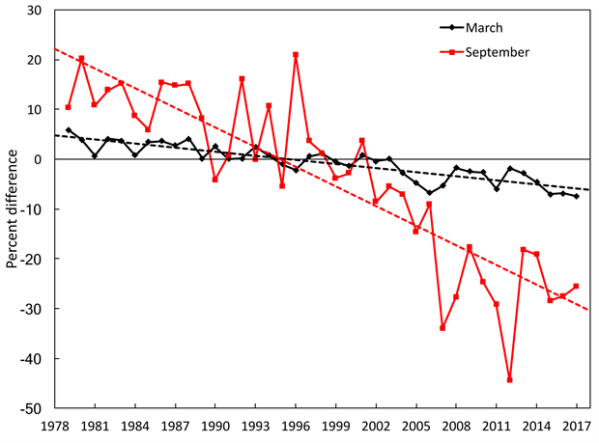NOAA’s 2017 Arctic Report Card Shows Transition Toward Not-Normal Polar Environment Continues
The
Arctic shows no sign of returning to the reliably frozen region of
recent past decades.—
NOAA
Reading
this [Arctic Report Card], I feel physically sick. I feel so anxious.
I’m not sure how many more years or months I’m going to be able
to work daily on climate change. —
Eric Holthaus
*****
12
December, 2017
During
2017, the Arctic experienced much warmer than normal winter and fall
temperatures. Meanwhile, according
to NOAA’s 2017 Arctic Report Card,
somewhat cool late spring and early summer temperatures did little to
abate a larger ongoing warming trend.
NOAA
notes:
The average surface air temperature for the year ending September 2017 is the 2nd warmest since 1900; however, cooler spring and summer temperatures contributed to a rebound in snow cover in the Eurasian Arctic, slower summer sea ice loss, and below-average melt extent for the Greenland ice sheet.
(NOAA’s
Arctic Report Card shows a Polar environment experiencing serious and
harmful changes.)
This
warming trend was evidenced by continued systemic long term sea ice
losses with NOAA stating that sea ice cover has continued to thin
even as older, thicker
ice comprised only 21 percent of Arctic Ocean coverage compared to 45
percent during 1985.
NOAA noted very slow Chukchi and Barents sea ice re-freeze during
fall of 2017 — which was a feature of much warmer than typical sea
surface temperatures during late August. Temperatures which ranged up
to 4 C above average for this time of year and that created a kind of
heat barrier to typical fall ice cover expansion.
Sea
ice is a primary indicator of Arctic health. But losses over recent
decades have been quite precipitious as indicated by the graph below:

NOAA
also found evidence of ongoing increases in ocean productivity in the
far north — which tends to be triggered by increasing temperature
and rising ocean carbon uptake (also a driver of acidification).
Other
observations of systemic warming came as permafrost temperatures hit
record levels during 2016. Decadal
rates of permafrost warming as measured at Dead Horse along the North
Slope of Alaska proceeded at a rate of 0.21 to 0.66 degrees Celsius
every ten years.
(Changes
in Arctic ground temperature [20 meter depth] at varying locations
shows widespread movement toward permafrost thaw. Image
source: NOAA.)
Long-term trends (1982-2016) show greening on the North Slope of Alaska, the southern Canadian tundra, and in the central Siberian tundra; tundra browning is found in western Alaska (Yukon-Kuskokwim Delta), the higher-Arctic Canadian Archipelago, and western Siberian tundra.
Rapid
warming of the Arctic, loss of sea ice, permafrost thaw, greening
tundra, changes in ocean productivity and other factors are all
starting to seriously impact the people of the Arctic. Coastal towns
have been forced to move inland due to erosion and sea level rise.
And a number of communities have lost access to key food sources due
to sea ice loss or migration of local species away from warming
regions. Subsidence has generated harmful impacts to infrastructure.
Meanwhile, the increased incidence of Arctic wildfires presents a rising hazard to Northern Communities:
Meanwhile, the increased incidence of Arctic wildfires presents a rising hazard to Northern Communities:
High latitude fire regimes appear to be responding rapidly to environmental changes associated with a warming climate; although highly variable, area burned has increased over the past several decades in much of Boreal North America. Most acreage burned in high latitude systems occurs during sporadic periods when lightning ignitions coincide with warm and dry weather that cures vegetation and elevates fire danger. Under a range of climate change scenarios, analyses using multiple approaches project significant increases (up to four-fold) in area burned in high latitude ecosystems by the end of the 21st century.
Taken
together this is tough news — a technical report written in the
lingo of science but that, in broad brush, describes evidence of a
world fundamentally changed. For those of us with sensitive hearts,
it’s a rough thing to write about:
Reading this, I feel physically sick. I feel so anxious. I'm not sure how many more years or months I'm going to be able to work daily on climate change. Today is one of those days.
Overall, NOAA calls for increased efforts to adapt to climate change in the far north. In addition, the need for mitigating harms from climate change by speeding a transfer to renewable energy could help to preserve cryosystems and ecosystems that are now under increasingly severe threat.




No comments:
Post a Comment
Note: only a member of this blog may post a comment.